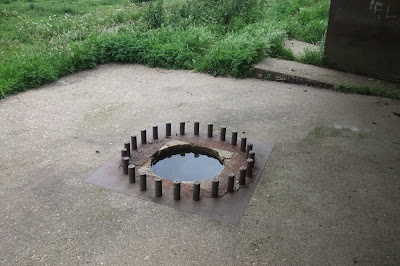Above: Aerial in which the series of craters are clearly visible. Bottom shows a GPS plot of four rows.
Documentary evidence shows minefields in the area from 1940 onwards, but the only document I've found to date which states the type of minefield is from 1942. The extent of the minefields in this area were certainly increased between 1940 to 1942.
Above: The craters are in the dunes, just to the north of the line of anti-tank blocks. Middle image shows one of the craters, with the tank blocks in the distance while the crater in the bottom image is quite evident.
The 1942 document suggests that the mines in this area were 'Beach' Mines - which normally referred to Naval Beach B Type "C" and were issued from Naval Depots to Home Forces up to December 1942 when the Navy ceased to supply any more. They were filled with approx 20 lbs of Amatol. The 1940 guidelines for laying Beach Mines stated that they should be laid in two or three rows with at least 20 ft between each mine.The rows were to be staggered so as to present a frontage with small gaps only. Beach Mines were only meant to be a temporary issue as a result of the Invasion scare and were only suitable for beach defence (as their name suggests!)
Above: 1942 map of minefield
So how does the series of small craters that exist today fit in with the documentary evidence? The distance between the centre of each crater in each row was approx 18 to 20 ft. There are four rows of craters, which may correspond to the 1942 map - this shows two rows made up with 120 mines and two rows made up with 105 mines. The best preserved craters are approx nine ft in diameter and two ft deep. I don't know the size of crater a Beach Mine would make - the only mention of mine craters I have found is for anti-tank mines which may make a crater up to five ft wide and three ft deep in soft ground. With the ground in this area being vegetated shingle and sand, it should be remembered that the original dimensions of the crater will not be preserved today after 70 odd years!
So why would the mines have exploded? The explosion of minefields during the war was not an uncommon occurrence. Stray dogs were a often a cause, exploding one mine which either caused sympathetic detonation of a number of mines or the the blast would cause compression of the striker springs of adjacent mines if placed too close together. The mines may also have been deliberately destroyed in situ - either to remove the minefield completely or in preparation for laying a new minefield. To date I have found no documentary evidence for an explosion or removal of mines in this area, although it may be sitting in the depths of my hard drive somewhere!
I should of course end by stating that they may not be mine craters at all - it would not be the first time, nor no doubt the last time, that I mistake another feature as WW2 evidence! If anyone knows otherwise I would love to hear!
WW2 and Nuclear Energy have both left their mark in Sizewell's Landscape!
As well as these craters, I also noted some remains of 'dragons teeth' i.e. under water spikes. These were of two types: 12" by 5" girder laid at 15 ft intervals and a smaller type.
Above: Top three images show the larger type of under water spike. Fourth image shows the smaller type of spike. Bottom image shows remains of both types of spikes, just after the war.
Finally, the 1942 Obstacle Crossing Demonstration, a popular thread in this blog, is now on the website under the Training Tab, with the outcome of the demonstration having come to light on my last visit to the National Archives.



















